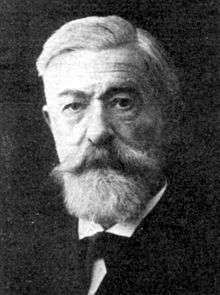Julius Schubring

Johannes Julius Schubring (28 March 1839, Dessau – 5 June 1914) was a German classical scholar, known for his studies on the archaeological topography of Sicily. He was the son of clergyman Julius Schubring (1806–1889).
From 1857 to 1862 he obtained his education at the universities of Erlangen, Bonn and Göttingen, and afterwards spent several years working as a tutor in Sicily. In 1868 he was appointed head teacher at the Katharineum in Lübeck,[1] where in 1880 he succeeded Johann Friedrich Breier (1813–1880) as director.[2]
Trivia
After te death of Senator Mann in 13 October 1891 consul Hermann Wilhelm Fehling and the merchand of wine Karl Tesdorpf became Legal guardians of his five children.
At this time Thomas Mann was sixteen years old. We meet Julius Schubring in the first novel in Buddenbrooks of Thomas Mann as Head teacher Prof. Wulicke.[3] In 1929 he got the Nobel Prize for this novel.
Selected works
- Achradina. Ein Beitrag zur Stadtgeschichte von Syrakus, 1865 – Achradina: a contribution to the local history of Syracuse.
- Sicilische Studien. - Kamikos - Trickala - Caltabellotta, 1866 – Sicilian studies. Kamikos; Trickala; Caltabellotta.
- Akrä-Palazzolo. Eine topographisch-archäologische Skizze, 1867 – Akrai-Palazzolo: a topographical and archaeological sketch.
- Historische Topographie von Akragas in Sicilien während der klassischen Zeit, 1870 – Historical topography of Akragas in Sicily during the Classical period.
- Historische Topographie von Panormus, 1870 – Historical topography of Panormus.
- Kamarina, 1873 – Kamarina.[4]